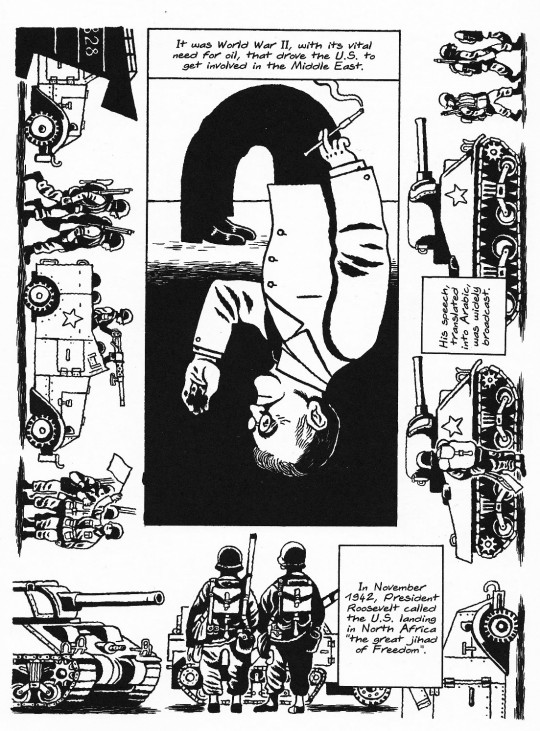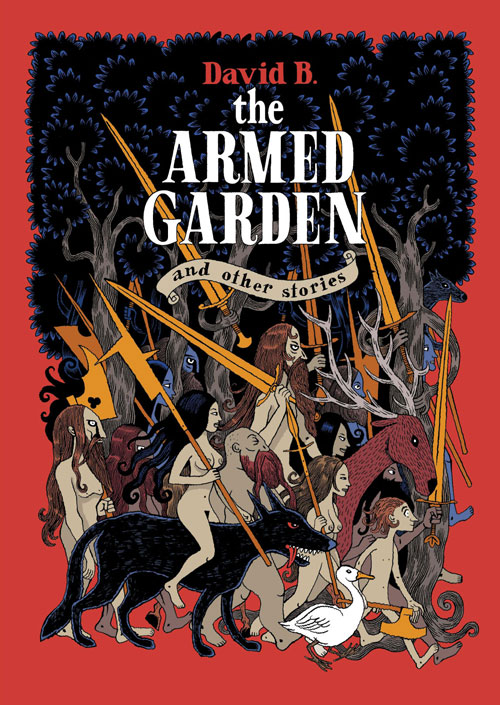Posts Tagged ‘David B.’
Comics Time: Best of Enemies: A History of US and Middle East Relations – Part One: 1783-1953
June 12, 2012Best of Enemies: A History of US and Middle East Relations – Part One: 1783-1953
Jean-Pierre Filiu, writer
David B., artist
SelfMadeHero, 2012
120 pages
$24.95
Buy it from SelfMadeHero
Buy it from Amazon.com
For today’s Comics Time review, please visit The Comics Journal.
The 20 Best Comics of 2011
January 1, 201220. Uncanny X-Force (Rick Remender and Jerome Opeña, Marvel): In a year when the ugliness of the superhero comics business became harder than ever to ignore, it’s fitting that the best superhero comic is about the ugliness of being a superhero. Remender uses the inherent excess of the X-men’s most extreme team to tell a tale of how solving problems through violence in fact solves nothing at all. (It has this in common with most of the best superhero comics of the past decade: Morrison/Quitely/etc. New X-Men, Bendis/Maleev Daredevil, Brubaker/Epting/etc. Captain America, Mignola/Arcudi/Fegredo/Davis Hellboy/BPRD, Kirkman/Walker/Ottley Invincible, Lewis/Leon The Winter Men…) Opeña’s Euro-cosmic art and Dean White’s twilit color palette (the great unifier for fill-in artists on the title) could handle Remender’s apocalyptic continuity mining easily, but it was in silent reflection on the weight of all this death that they were truly uncanny.
19. The League of Extraordinary Gentlemen Vol. 3: Century #2: 1969 (Alan Moore and Kevin O’Neill, Top Shelf/Knockabout): I’ll admit I’m somewhat surprised to be listing this here; I’ve always enjoyed this last surviving outpost of Moore’s comics career but never thought I loved it. But in this installment, Moore and O’Neill’s intrepid heroes — who’ve previously overcome Professor Moriarty, Fu Manchu, and the Martian war machine — finally succumb to their own excesses and jealousies in Swinging London, allowing a sneering occult villain to tear them apart with almost casual ease. It’s nasty, ugly, and sad, and it’s sticking with me like Moore’s best work.
18. The comics of Lisa Hanawalt (various publishers): As I put it when I saw her drawing of some kind of tree-dwelling primate wearing a multicolored hat made of three human skulls stacked on top of one another, Lisa Hanawalt has a strange imagination. And it’s a totally unpredictable one, which is what makes her comics – whether they’re reasonably straightforward movie lampoons or the extravagantly bizarre sex comic she contributed to Michael DeForge and Ryan Sands’s Thickness anthology, as dark and damp as the soil in which its earthworm ingénue must live – a highlight of any given day a new one pops up.
17. Daybreak (Brian Ralph, Drawn and Quarterly): Fort Thunder’s single most accessible offspring also proves to be its bleakest, thanks to an extended collected edition that converts a rollicking first-person zombie/post-apocalypse thriller into a troubling meditation on the power of the gaze. Future artcomics takes on this subgenre have a high bar to clear.
16. Habibi (Craig Thompson, Pantheon): It’s undermined by its central characters, who exist mainly as a hanger on which this violent, erotic, conflicted, curious, complex, endlessly inventive coat of many colors is hung. But as a pure riot of creative energy from an artist unafraid to wrestle with his demons even if the demons end up winning in the end, Habibi lives up to its ambitions as a personal epic. You could dive into its shifting sands and come up with something different every time.
15. Ganges #4 (Kevin Huizenga, Coconino/Fantagraphics): Huizenga wrings a second great book out of his everyman character’s insomnia. It’s quite simple how, really: He makes comics about things you’d never thought comics could be about, by doing things you never thought comics could do to show you them. Best of all, there’s still the sense that his best work is ahead of him, waiting like dawn in the distance.
14. The Congress of the Animals (Jim Woodring, Fantagraphics): The potential for change explored by the hapless Manhog in last year’s Weathercraft is actualized by the meandering mischief-maker Frank this time around. While I didn’t quite connect with Frank’s travails as deeply as I did with Manhog’s, the payoff still feels like a weight has been lifted from Woodring’s strange world, while the route he takes to get there is illustrated so beautifully it’s almost superhuman. It’s the happy ending he’s spent most of his career earning.
13. Mister Wonderful (Daniel Clowes, Pantheon): Speaking of happy endings an altcomix luminary has spent most of his career earning! Clowes’s contribution to the late, largely unlamented Funny Pages section of The New York Times Magazine is briefly expanded and thoroughly improved in this collected edition. Clowes reformats the broadsheet pages into landscape strips, eases off the punchlines and cliffhangers, blows individual images up to heretofore unseen scales, and walks us through a self-sabotaging doofus’s shitty night into a brighter tomorrow.
12. The comics of Gabrielle Bell (various publishers): Bell is mastering the autobiography genre; her deadpan character designs and body language make everything she says so easy to buy – not that that would be a challenge with comics as insightful as her journey into nerd culture’s beating heart, San Diego Diary, just by way of a for instance. But she’s also reinventing the autobiography genre, by sliding seamlessly into fictionalized distortions of it; her black-strewn images give a somber, thoughtful weight to any flight of fancy she throws at us. What a performance, all year long.
11. The Armed Garden and Other Stories (David B., Fantagraphics): Religious fundamentalism is a dreary, oppressive constant in its ability to bend sexuality to mania and hammer lives into weapons devoted to killing. But it has worn a thousand faces in a millennia-long carnevale procession of war and weirdness, and David B. paints portraits of three of its masks with bloody brilliance. Focusing on long-forgotten heresies and treating the most outlandish legends about them as fact, B.’s high-contrast linework sets them all alight with their own incandescent madness.
10. Too Dark to See (Julia Gfrörer, Thuban Press): It was a dark year for comics, at least for the comics that moved me the most. And no one harnessed that darkness to relatable, emotional effect better than Julia Gfrörer. Her very contemporary take on the legend of the succubus was frank and explicit in its treatment of sexuality, rigorously well-observed in its cataloguing of the spirit-sapping modern-day indignities that can feed depression and destroy relationships, and delicately, almost tenderly drawn. It’s like she held her finger to the air, sensed all the things that can make life rotten, and cast them onto the pages. She made something quite beautiful out of all that ugly.
9. The comics and pixel art of Uno Moralez (self-published on the web at unomoralez.com): What if an 8-bit NES cut-scene could kill? The digital artwork of Uno Moralez — some of it standard illustrations, some of it animated gifs, some of it full-fledged comics — shares its aesthetic with The Ring‘s videotape or Al Columbia’s Pim & Francie: a horror so cosmically black, images so unbearably wrong, that they appear to have leaked into and corrupted their very medium of transmission. Moralez fuses crosses the streams of supernatural trash from a variety of cultures — the legends and Soviet art of his native Russia, the horror and porn manga of Japan, the B-movies and horror stories of the States, the formless sensation aesthetic of the Internet itself — into a series of images that is impossible to predict in its weirdness but totally unflagging in its sense that you’d be better off if you’d never laid eyes on it. I can’t wait to see more.
8. The comics of Michael DeForge (various publishers): The last time you saw a cartoonist this good and this unique this young, you were probably reading the UT Austin student newspaper comics section and stumbling across a guy named Chris Ware. All four of DeForge’s best-ever comics — his divorced dad story in Lose #3, his shape-shifting/gender-bending erotica in Thickness #2, his self-published art-world fantasia Open Country, and his gorgeously colored body-horror webcomic Ant Comic — came out this year, none of them looking anything at all like anything you could picture before seeing your first Michael DeForge comic. It’s almost frightening to think where he’ll be five years from now, ten years from now…or even just this time next year.
7. The comics and art of Jonny Negron (various publishers): What if someone took Christina Hendricks’s walk across the parking lot and trip to the bathroom in Drive and made an entire comics career out of them? That is an enormously facile and reductive way to describe the disturbing, stylish, sexy, singular work of Jonny Negron, the breakout cartoonist of the year, but it at least points you in the right direction. No one’s ever thought to combine his muscular yet curiously dispassionate bullet-time approach to action and violence, his Yokoyama-esque spatial geometry, his attention to retrofuturistic fashion and style, his obvious love of the female body in all its shapes and sizes, and his ambient Lynchian terror; even if they had, it’d be tough to conceive of anyone building up his remarkable body of work in such a short period of time. Open up your Tumblr dashboard or crack an anthology (Thickness, Mould Map, Study Group, Smoke Signal, Negron and Jesse Balmer’s own Chameleon), and chances are good that Negron was the weirdest, best, most coldly beautiful thing in it. It’s like a raw, pure transmission from a fascinating brain.
6. The Wolf (Tom Neely, I Will Destroy You): Neely’s wordless, painted, at-times pornographic graphic novel feels like the successful final draft to various other prestigious projects’ false starts. It’s a far less didactic, more genuinely erotic attempt at high-art smut than Dave McKean’s Celluloid; a less self-conscious, more direct attempt at frankly depicting both the destructive and creative effects of sex on a relationship via symbolism than Craig Thompson’s Habibi; a blend of sex and horror and narrative and visual poetry and ugly shit and a happy ending that succeeds in each of these things where many comics choose to focus on only one or two.
5. The Cardboard Valise (Ben Katchor, Pantheon): Prep your time capsules, folks: You’d be hard pressed to find an artifact that better conveys our national predicament than Ben Katchor’s latest comic-strip collection, a series of intertwined vignettes created largely before the Great Recession and our political class’s utter failure to adequately address it, but which nonetheless appears to anticipate it. Its message — that blind nationalism is the prestige of the magic trick used by hucksters to financially and culturally ruin societies for their own profit — is delightfully easy to miss amid Katchor’s remarkable depictions of lost fads, trends, jobs, tourist attractions, and other detritus of the dying American Century. He’s the very most funnest Cassandra around.
4. Love from the Shadows (Gilbert Hernandez, Fantagraphics): I picture Gilbert Hernandez approaching his drawing board these days like Lawrence of Arabia approaching a Turkish convoy: “NO PRISONERS! NO PRISONERS!” In a year suffused with comics funneling pitch-black darkness through a combination of sex and horror, none were blacker, sexier, or more horrific than this gender-bending exploitation flick from Beto’s “Fritz-verse.” None also functioned as a rejection of the work that made its creator famous like this one did, either. Not a crowd-pleaser like his brother, but every bit as brilliant, every bit as fearless.
3. Garden (Yuichi Yokoyama, PictureBox): Like a theme park ride in comics form — with the strange events it chronicles themselves resembling a theme park ride — Yokoyama’s book is a breathtaking, breathless experience. Alongside his anonymous but extravagantly costumed non-characters, we simply go along for the ride, exploring Yokoyama’s prodigious, mysterious imagination as he concocts a seemingly endless stream of increasingly strange interfaces between man and machine, nature and artifice. As a metaphor for our increasingly out-of-control modern life it’s tough to top. As pure thrilling kinetic cartooning it’s equally tough to top.
2. Big Questions (Anders Nilsen, Drawn & Quarterly): Last year, I wrote that if the collected edition of Nilsen’s long-running parable of philosophically minded birds and the plane crash that turns their lives upside-down didn’t top my list whenever it came out, it must have been some kind of miracle year. Turns out that it was. But you’d pretty much have to create a flawless capstone to a thirty-year storyline of neer-peerless intelligence and artistry to top this colossal achievement. Nilsen’s painstaking, pointillist cartooning and ruthless examination of just how little regard the workings of the world have for any given life, human or otherwise, marks him as the best comics artist of his generation, and solidifies Big Questions‘ claim as the finest “funny animal” comic since Maus.
1. Love and Rockets: New Stories #4 (Gilbert and Jaime Hernandez, Fantagraphics): Gilbert got his due elsewhere on my list, so let’s ignore his contribution to this issue, which advance the saga of his bosomy, frequently abused protagonist Fritz Martinez both on and off the sleazy silver screen. Instead, let’s add to the chorus praising Jaime’s “The Love Bunglers” as one of the greatest comics of all time, the point toward which one of the greatest comics series of all time has been hurtling for thirty years. In a single two-page spread Jaime nearly crushes both his lovable, walking-disaster main characters Maggie and Ray with the accumulated weight of all their decades of life, before emerging from beneath it like Spider-Man pushing up from out of that Ditko machinery. You can count the number of cartoonists able to wed style to substance, form to function, this seamlessly on one hand with fingers to spare. A masterpiece.
Comics Time: The Armed Garden and Other Stories
December 23, 2011The Armed Garden and Other Stories
David B., writer/artist
Fantagraphics, 2011
112 pages, hardcover
$19.99
Read a 10-page preview and buy it from Fantagraphics
Buy it from Amazon.com
About the only things impeding my completely unfettered enjoyment of and admiration for everything David B. achieves in The Armed Garden and Other Stories are familiarity — all three of the stories collected here appeared in the late, lamented Mome anthology at some point; and, because I am a morose and unpleasant person, the happy-ish ending — after a book of unremitting, near-ecstatic horror and slaughter, ending on a wistful up-note felt not so much unearned as simply unwanted.
But that’s it. Other than that, this collection is absolutely marvelous, a gorgeous and searing series of comics from an artist who earns the description “freakishly talented” as completely as anyone this side of his trans-Atlantic fellow in crafting dreamy/nightmarish parables of violent spirituality, Jim Woodring. These comics are just as lovely and just as frightening, and just as singularly the work of their creator and no other.
For one thing, they’re beyond gorgeous. B. has developed a form of expressionism that relies on curves rather than angles; simultaneously he’s fleshed out the stark intensity of his high-contrast black-and-white brush art with a lush duotone gold. The result is battle scenes that have the sharpness and savagery of a woodcut and the graphic simplicity of a Dark Ages tapestry, tied to prophetic visions and hedonistic reveries among the faithful peopled by characters you want to reach out and hug, so sensuous and inviting they seem. It’s almost unfair that the same guy who’s developed a visual language for battle that eloquently reduces its participants to interlocking graphic elements, a nigh-undifferentiated sea of swords, spears, grimaces, and gouts of blood, also maybe draws the sexiest pale naked women I’ve ever seen in a comic. But from a thematic perspective these stories are all about the way that religious fervor lends an air of all-consuming certainty and nobility to mankind’s most animalistic pursuits, from fucking to killing, so I suppose it’s only fitting.
Each of The Armed Garden‘s three stories — “The Veiled Prophet,” the title tale, and “The Drum Who Fell in Love” — is a transmission from the heightened reality of the legends surrounding various medieval religious cults, one from Arab Islam and two warring ones from European Christianity. As I mentioned when the first of these, “The Veiled Prophet,” hit our shores in Mome, they at first appear to all the world like an expressionistically drawn work of historical fiction, until the supernatural elements slowly take over. By focusing on the individual actors in each drama rather than the overall sweep of the history surrounding them, B. allows the reader to experience the awe and terror of divine/demonic intervention as a first-hand phenomenon; within the world of the stories, it’s as easy to swallow as are the more run of the mill sources of conflict with rival Popes and caliphs and so on. We get swept up in the madness and terror along with everyone else. And in all three cases, the fire of divinity burns too bright, consuming those who fan its flames. Provided you don’t buy its actual intervention in actual real life — and by situating each story within rejected, discredited cults, B. effectively removes the need to consider the more popular and lasting religions in this light — the message is clear: Belief in this shit, actualized into violence, will drive you as crazy and destroy you as completely as the real deal will. Gazing beneath the veil of the prophet, building your own paradise on earth, peering into the secrets of creation, communing with the dead, slaughtering out a path for God to tread — these things will kill you, blind you, drive you insane, leave you stranded with only the music of your mind for company. Ugly truths, presented as beautifully as is humanly possible.



